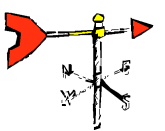
Wind
 The air is nearly always in motion, and this is felt as wind. Two factors are necessary to specify wind, its speed and direction. The direction of wind is expressed as the point of the compass from where the wind is blowing. Air moving from the northeast to the southwest is called a northeast wind. It may also be expressed in degrees from true north. A northeast wind would be 45°. A southwest wind would be 235°. The wind speed can be expressed in miles or kilometres per hour, meters per second, knots or as a force on the Beaufort scale.
The air is nearly always in motion, and this is felt as wind. Two factors are necessary to specify wind, its speed and direction. The direction of wind is expressed as the point of the compass from where the wind is blowing. Air moving from the northeast to the southwest is called a northeast wind. It may also be expressed in degrees from true north. A northeast wind would be 45°. A southwest wind would be 235°. The wind speed can be expressed in miles or kilometres per hour, meters per second, knots or as a force on the Beaufort scale.
Wind develops as a result of pressure or temperature differences between two locations on the Earth's surface. Sea breezes for example, develop due to the differential heating of land and sea at the coast during warm sunny days. Winds also blow out from high-pressure regions or anticyclones and into low-pressure regions, for example depressions. The wind however, does not blow in a straight line, but follows a spiralling path because large movements of air are deflected by the Coriolis force as a result of the Earth's rotation. At a global scale, the temperature and pressure differences across the latitudes of the Earth generate the global wind belts.
Websites
Other topics
• Wild Weather Page
• Wind Instruments
• USA Today
• USA Today
• Chain Reaction
• Franklin Institute
• Wind
• K8 Aeronautics
• Weather Station
• Weather Gone Wild
• Measuring Wind
• C@wley.Net
• Introduction to Weather
• Anticyclones
• Beaufort Scale
• Cirrus Clouds
• Clouds
• Cold Fronts
• Condensation
• Convection
• Cooling Air
• Cumulonimbus Clouds
• Cumulus Clouds
• Depressions
• Dew
• Dew Point
• Energy
• Evaporation
• Fog
• Forecasting
• Fronts
• Frost
• Humidity
• Hurricanes
• Isobars
• Measuring Weather
• Meteorology
• Monsoons
• Movement of Air
• Occluded Fronts
• Precipitation
• Pressure
• Sea Breeze
• Stability of Air
• Stratus Clouds
• Sunshine
• Synoptic Charts
• Temperature
• Thunderstorms
• Tornadoes
• Uplift of Air
• Warm Fronts
• Water Cycle
• Weather Symbols
• Wind
 Print Topic
Print Topic